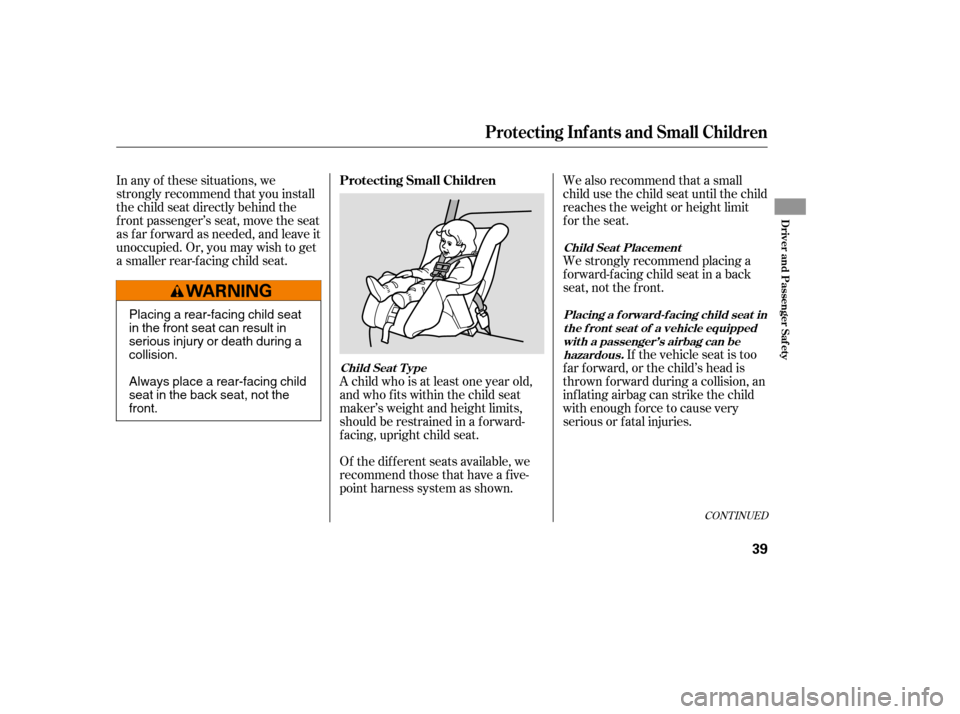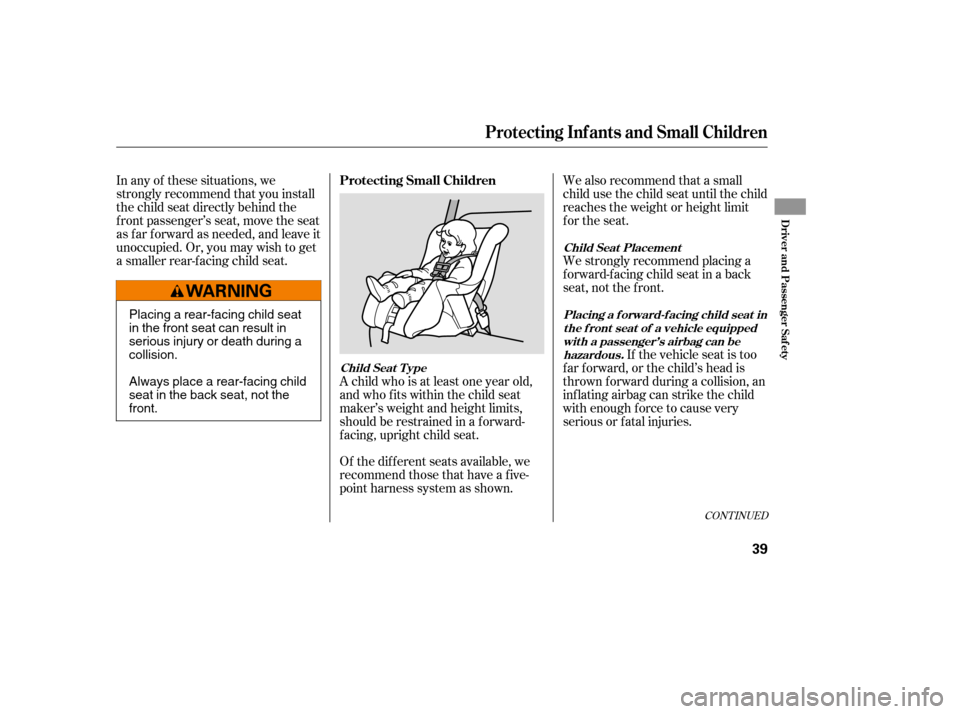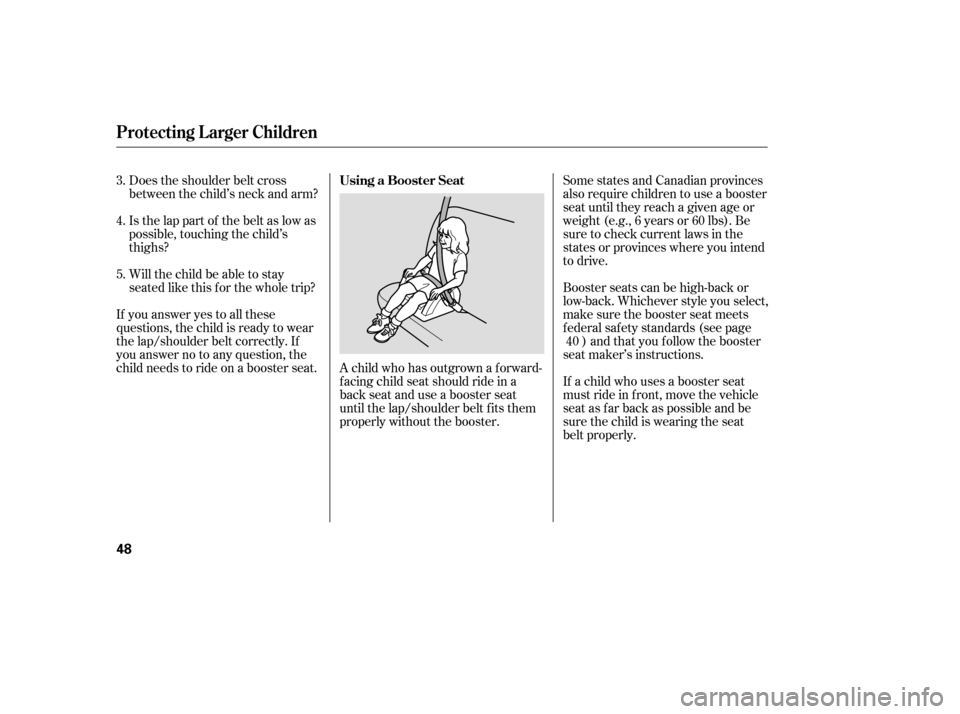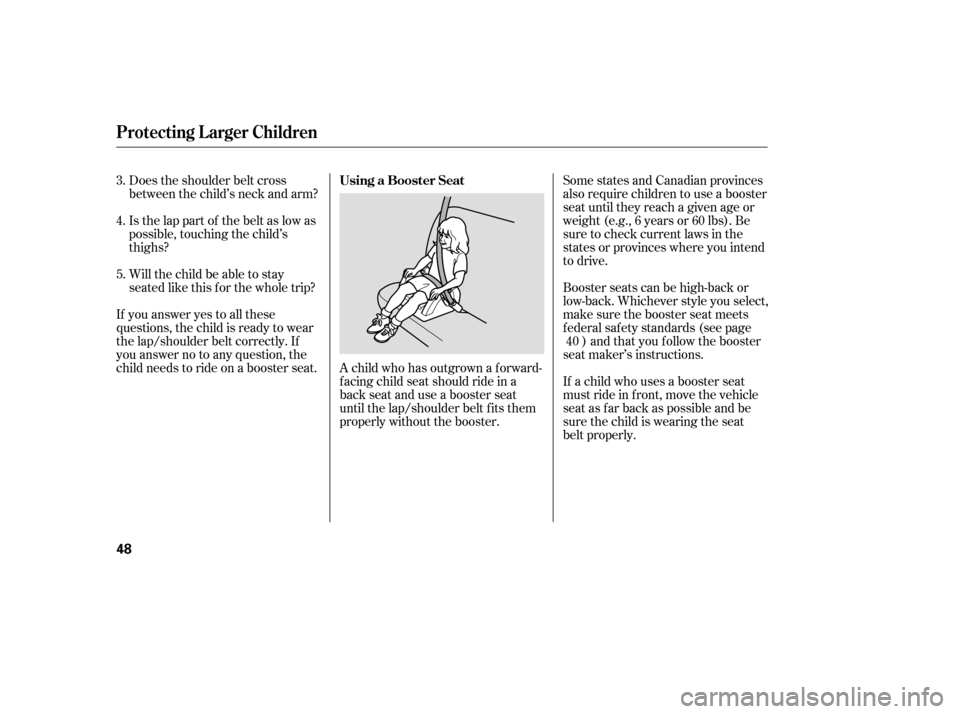Page 49 of 435

CONT INUED
If the vehicle seat is too
f ar f orward, or the child’s head is
thrown f orward during a collision, an
inf lating airbag can strike the child
with enough force to cause very
serious or f atal injuries.
We strongly recommend placing a
forward-facing child seat in a back
seat, not the f ront.
We also recommend that a small
child use the child seat until the child
reaches the weight or height limit
for the seat.
Of the different seats available, we
recommend those that have a f ive-
point harness system as shown.
In any of these situations, we
strongly recommend that you install
the child seat directly behind the
f ront passenger’s seat, move the seat
as far forward as needed, and leave it
unoccupied. Or, you may wish to get
a smaller rear-f acing child seat.
A child who is at least one year old,
and who fits within the child seat
maker’s weight and height limits,
should be restrained in a f orward-
f acing, upright child seat.
Protecting Inf ants and Small Children
Placing a f orward-f acing child seat int he f ront seat of a vehicle equipped
with a passenger’s airbag can behazardous.
Child Seat Placement
Child Seat T ype
Protecting Small Children
Driver and Passenger Saf ety
39
Placing a rear-facing child seat
in the front seat can result in
serious injury or death during acollision.
Always place a rear-facing child
seat in the back seat, not thefront.
�����—�����—�
���y�
�
��
��������y���
�)�����������y���������y
Page 50 of 435

CONT INUED
If the vehicle seat is too
f ar f orward, or the child’s head is
thrown f orward during a collision, an
inf lating airbag can strike the child
with enough force to cause very
serious or f atal injuries.
We strongly recommend placing a
forward-facing child seat in a back
seat, not the f ront.
We also recommend that a small
child use the child seat until the child
reaches the weight or height limit
for the seat.
Of the different seats available, we
recommend those that have a f ive-
point harness system as shown.
In any of these situations, we
strongly recommend that you install
the child seat directly behind the
f ront passenger’s seat, move the seat
as far forward as needed, and leave it
unoccupied. Or, you may wish to get
a smaller rear-f acing child seat.
A child who is at least one year old,
and who fits within the child seat
maker’s weight and height limits,
should be restrained in a f orward-
f acing, upright child seat.
Protecting Inf ants and Small Children
Placing a f orward-f acing child seat int he f ront seat of a vehicle equipped
with a passenger’s airbag can behazardous.
Child Seat Placement
Child Seat T ype
Protecting Small Children
Driver and Passenger Saf ety
39
Placing a rear-facing child seat
in the front seat can result in
serious injury or death during acollision.
Always place a rear-facing child
seat in the back seat, not thefront.
�����—�����—�
���y�
�
��
��������y���
�)�����������y���������y
Page 58 of 435
Af ter conf irming that the belt is
locked, grab the shoulder part of
the belt near the buckle, and pull
up to remove any slack from the
lap part of the belt. Remember, if
the lap part of the belt is not tight,
the child seat will not be secure.To deactivate the lockable retractor
and remove a child seat, unlatch the
buckle, unroute the seat belt, and let
the belt fully retract.
Push and pull the child seat
f orward and f rom side-to-side to
verif y that it is secure enough to
stay upright during normal driving
maneuvers. If the child seat is not
secure, unlatch the belt, allow it to
retract f ully, then repeat these
steps.
To remove slack, it may help to
putweightonthechildseat,or
push on the back of the seat while
pulling up on the belt.
4.
5.
Installing a Child Seat
Driver and Passenger Saf ety
45
�����—�����—�
���y�
�
��
��������y���
�)�����������y���������y
Page 60 of 435

To determine if a lap/shoulder belt
properly f its a child, have the child
put on the seat belt, then ask
yourself :
When a child reaches the
recommended weight or height limit
for a forward-facing child seat, the
child should sit in a back seat on a
booster seat and wear a lap/shoulder
belt.
Does the child sit all the way back
against the seat?
Do the child’s knees bend
comf ortably over the edge of the
seat?
The f ollowing pages give
instructions on how to check proper
seat belt f it, what kind of booster
seat to use if one is needed, and
important precautions f or a child
who must sit in f ront.
1. 2.
CONT INUED
Protecting L arger Children
Checking Seat Belt Fit
Driver and Passenger Saf ety
47
Allowing a child age 12 or under
to sit in front can result in injury
or death if the passenger’s front
airbag inflates.
If a child must ride in front,
move the vehicle seat as far
back as possible, use a booster
seat if needed, have the child
sit up properly and wear the
seat belt properly.
�����—�����—�
���y�
�
��
��������y���
�)�����������y���������y
Page 61 of 435

Does the shoulder belt cross
between the child’s neck and arm?
Is the lap part of the belt as low as
possible, touching the child’s
thighs?
Will the child be able to stay
seated like this f or the whole trip?
If you answer yes to all these
questions, the child is ready to wear
the lap/shoulder belt correctly. If
you answer no to any question, the
child needs to ride on a booster seat. A child who has outgrown a f orward- f acing child seat should ride in a
back seat and use a booster seat
until the lap/shoulder belt f its them
properly without the booster.Some states and Canadian provinces
also require children to use a booster
seat until they reach a given age or
weight (e.g., 6 years or 60 lbs). Be
sure to check current laws in the
states or provinces where you intend
to drive.
Booster seats can be high-back or
low-back. Whichever style you select,
make sure the booster seat meets
f ederal saf ety standards (see page
) and that you f ollow the booster
seat maker’s instructions.
If a child who uses a booster seat
must ride in f ront, move the vehicle
seat as far back as possible and be
sure the child is wearing the seat
belt properly.
4. 5.
3.
40
Using a Booster Seat
Protecting L arger Children
48
�����—�����—�
���y�
�
��
��������y���
�)�����������y���������y
Page 62 of 435

Does the shoulder belt cross
between the child’s neck and arm?
Is the lap part of the belt as low as
possible, touching the child’s
thighs?
Will the child be able to stay
seated like this f or the whole trip?
If you answer yes to all these
questions, the child is ready to wear
the lap/shoulder belt correctly. If
you answer no to any question, the
child needs to ride on a booster seat. A child who has outgrown a f orward- f acing child seat should ride in a
back seat and use a booster seat
until the lap/shoulder belt f its them
properly without the booster.Some states and Canadian provinces
also require children to use a booster
seat until they reach a given age or
weight (e.g., 6 years or 60 lbs). Be
sure to check current laws in the
states or provinces where you intend
to drive.
Booster seats can be high-back or
low-back. Whichever style you select,
make sure the booster seat meets
f ederal saf ety standards (see page
) and that you f ollow the booster
seat maker’s instructions.
If a child who uses a booster seat
must ride in f ront, move the vehicle
seat as far back as possible and be
sure the child is wearing the seat
belt properly.
4. 5.
3.
40
Using a Booster Seat
Protecting L arger Children
48
�����—�����—�
���y�
�
��
��������y���
�)�����������y���������y
Page 72 of 435

This indicator comes on brief ly when
you turn the ignition switch to the
ON (II) position. If it comes on at
any other time, it indicates a
potential problem with your f ront
airbags. This indicator will also alert
you to a potential problem with your
side airbags, passenger’s side airbag
cutof f system, side curtain airbags,
automatic seat belt tensioners,
driver’s seat position sensor, or the
f ront passenger’s weight sensors.
For more inf ormation, see page .
This indicator has two f unctions:
Itcomesonwhenyouturnthe
ignition switch to the ON (II)
position. It is a reminder to check
the parking brake. A beeper
sounds if you drive with the
parking brake not f ully released.
Driving with the parking brake not
fully released can damage the
brakes and tires.
If it remains lit af ter you f ully
release the parking brake while
the engine is running, or if it
comes on while driving, there
could be a problem with the brake
system. For more inf ormation, see
page . This indicator comes on brief ly when
you turn the ignition switch to the
ON (II) position. If it comes on at
any other time, it indicates that the
passenger’s side airbag has
automatically shut off. For more
inf ormation, see page .
1. 2. 2929
371 Supplemental Restraint
System Indicator
Parking Brake and Brake System
Indicator Side Airbag Of f Indicator
Instrument Panel Indicators
Inst rument s and Cont rols
57
U.S. Canada
Canada
U.S.
�����—�����—�
���y�
�
��
��������y���
�)�����������y���������y
Page 116 of 435

Make sure that the folded seat-back
does not press against the f ront
passenger’s seat, as this could cause
the weight sensors to work
improperly.Never drive with the seat-back
f olded down and the trunk lid open.
See on
page .
Make sure all rear shoulder belts are
positioned in f ront of the rear seat-
back, and the center shoulder belt is
re-positioned in the guide whenever
the seat-back is in its upright position.
Be sure there are no twists in any
shoulder belt.
Do not put any heavy items on the
seat-back when it is folded down.
Make sure all items in the trunk, or
items extending through the opening
into the back seat, are secured.
Looseitemscanflyforwardand
cause injury if you have to brake
hard. See on page
. To use the console lid as an armrest,
slide it to one of its three positions.
If the rear head restraints get caught
on the f ront seat backs and you
cannot fold down the rear seat-back
f ully, you can remove the head
restraints (see page ).
Make sure the removed head
restraints are securely stored.
To lock the seat-back upright, push it
f irmly against the trunk panel. Make
sure it is latched in place by pulling
on the top of the seat.
51
273
95
Seats
Carbon Monoxide Hazard
Carrying Cargo Armrest
98
Front
�����—�����—�
���y�
�
�����������y���
�)�����������y���
�����y